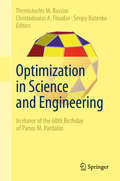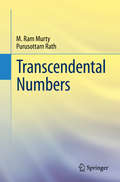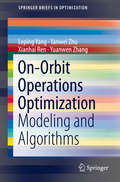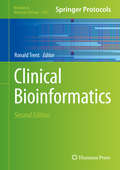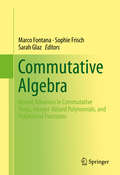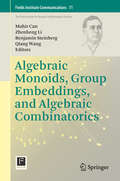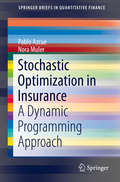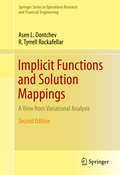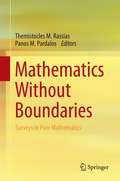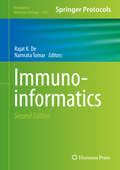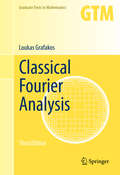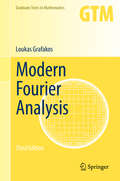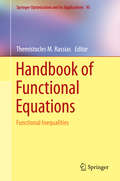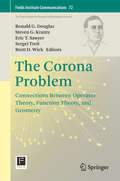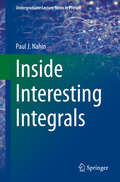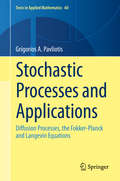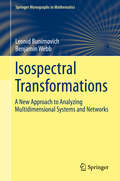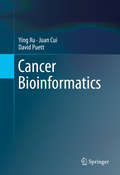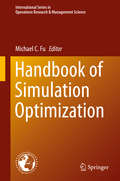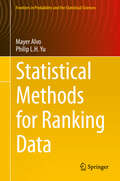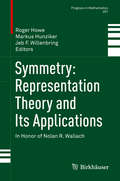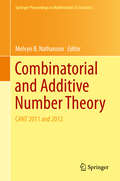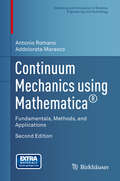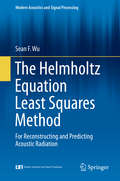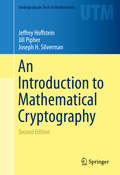- Table View
- List View
Optimization in Science and Engineering
by Sergiy Butenko Themistocles M. Rassias Christodoulos A. FloudasOptimization in Science and Engineering is dedicated in honor of the 60th birthday of Distinguished Professor Panos M. Pardalos. Pardalos's past and ongoing work has made a significant impact on several theoretical and applied areas in modern optimization. As tribute to the diversity of Dr. Pardalos's work in Optimization, this book comprises a collection of contributions from experts in various fields of this rich and diverse area of science. Topics highlight recent developments and include: Deterministic global optimization Variational inequalities and equilibrium problems Approximation and complexity in numerical optimization Non-smooth optimization Statistical models and data mining Applications of optimization in medicine, energy systems, and complex network analysis This volume will be of great interest to graduate students, researchers, and practitioners, in the fields of optimization and engineering.
Transcendental Numbers
by M. Ram Murty Purusottam RathThis book provides an introduction to the topic of transcendental numbers for upper-level undergraduate and graduate students. The text is constructed to support a full course on the subject, including descriptions of both relevant theorems and their applications. While the first part of the book focuses on introducing key concepts, the second part presents more complex material, including applications of Baker's theorem, Schanuel's conjecture, and Schneider's theorem. These later chapters may be of interest to researchers interested in examining the relationship between transcendence and L-functions. Readers of this text should possess basic knowledge of complex analysis and elementary algebraic number theory.
On-Orbit Operations Optimization
by Leping Yang Yanwei Zhu Xianhai Ren Yuanwen ZhangOn-orbit operations optimization among multiple cooperative or noncooperative spacecraft, which is often challenged by tight constraints and shifting parameters, has grown to be a hot issue in recent years. The authors of this book summarize related optimization problems into four planning categories: spacecraft multi-mission planning, far-range orbital maneuver planning, proximity relative motion planning and multi-spacecraft coordinated planning. The authors then formulate models, introduce optimization methods, and investigate simulation cases that address problems in these four categories. This text will serve as a quick reference for engineers, graduate students, postgraduates in the fields of optimization research and on-orbit operation mission planning.
Clinical Bioinformatics (Methods in Molecular Biology #1168)
by Ronald TrentIn Clinical Bioinformatics, Second Edition, leading experts in the field provide a series of articles focusing on software applications used to translate information into outcomes of clinical relevance. Recent developments in omics, such as increasingly sophisticated analytic platforms allowing changes in diagnostic strategies from the traditional focus on single or small number of analytes to what might be possible when large numbers or all analytes are measured, are now impacting patient care. Covering such topics as gene discovery, gene function (microarrays), DNA sequencing, online approaches and resources, and informatics in clinical practice, this volume concisely yet thoroughly explores this cutting-edge subject Written in the successful Methods in Molecular Biology series format, chapters include introductions to their respective topics, lists of the necessary materials and reagents, step-by-step, readily reproducible protocols, and notes on troubleshooting and avoiding known pitfalls. Authoritative and easily accessible, Clinical Bioinformatics, Second Edition serves as an ideal guide for scientists and health professionals working in genetics and genomics.
Commutative Algebra: Recent Advances in Commutative Rings, Integer-Valued Polynomials, and Polynomial Functions (De Gruyter Proceedings In Mathematics Ser.)
by Marco Fontana Sophie Frisch Sarah GlazThis volume presents a multi-dimensional collection of articles highlighting recent developments in commutative algebra. It also includes an extensive bibliography and lists a substantial number of open problems that point to future directions of research in the represented subfields. The contributions cover areas in commutative algebra that have flourished in the last few decades and are not yet well represented in book form. Highlighted topics and research methods include Noetherian and non- Noetherian ring theory as well as integer-valued polynomials and functions. Specific topics include: · Homological dimensions of Prüfer-like rings · Quasi complete rings · Total graphs of rings · Properties of prime ideals over various rings · Bases for integer-valued polynomials · Boolean subrings · The portable property of domains · Probabilistic topics in Intn(D) · Closure operations in Zariski-Riemann spaces of valuation domains · Stability of domains · Non-Noetherian grade · Homotopy in integer-valued polynomials · Localizations of global properties of rings · Topics in integral closure · Monoids and submonoids of domains The book includes twenty articles written by many of the most prominent researchers in the field. Most contributions are authored by attendees of the conference in commutative algebra held at the Graz University of Technology in December 2012. There is also a small collection of invited articles authored by those who did not attend the conference. Following the model of the Graz conference, the volume contains a number of comprehensive survey articles along with related research articles featuring recent results that have not yet been published elsewhere.
Algebraic Monoids, Group Embeddings, and Algebraic Combinatorics (Fields Institute Communications #71)
by Benjamin Steinberg Mahir Can Zhenheng Li Qiang WangThis book contains a collection of fifteen articles and is dedicated to the sixtieth birthdays of Lex Renner and Mohan Putcha, the pioneers of the field of algebraic monoids. Topics presented include: structure and representation theory of reductive algebraic monoids monoid schemes and applications of monoids monoids related to Lie theory equivariant embeddings of algebraic groups constructions and properties of monoids from algebraic combinatorics endomorphism monoids induced from vector bundles Hodge-Newton decompositions of reductive monoids A portion of these articles are designed to serve as a self-contained introduction to these topics, while the remaining contributions are research articles containing previously unpublished results, which are sure to become very influential for future work. Among these, for example, the important recent work of Michel Brion and Lex Renner showing that the algebraic semi groups are strongly π-regular. Graduate students as well as researchers working in the fields of algebraic (semi)group theory, algebraic combinatorics and the theory of algebraic group embeddings will benefit from this unique and broad compilation of some fundamental results in (semi)group theory, algebraic group embeddings and algebraic combinatorics merged under the umbrella of algebraic monoids.
Stochastic Optimization in Insurance
by Pablo Azcue Nora MulerThe main purpose of the book is to show how a viscosity approach can be used to tackle control problems in insurance. The problems covered are the maximization of survival probability as well as the maximization of dividends in the classical collective risk model. The authors consider the possibility of controlling the risk process by reinsurance as well as by investments. They show that optimal value functions are characterized as either the unique or the smallest viscosity solution of the associated Hamilton-Jacobi-Bellman equation; they also study the structure of the optimal strategies and show how to find them. The viscosity approach was widely used in control problems related to mathematical finance but until quite recently it was not used to solve control problems related to actuarial mathematical science. This book is designed to familiarize the reader on how to use this approach. The intended audience is graduate students as well as researchers in this area.
Implicit Functions and Solution Mappings
by R. Tyrrell Rockafellar Assen L. DontchevThe implicit function theorem is one of the most important theorems in analysis and its many variants are basic tools in partial differential equations and numerical analysis. This book treats the implicit function paradigm in the classical framework and beyond, focusing largely on properties of solution mappings of variational problems. The purpose of this self-contained work is to provide a reference on the topic and to provide a unified collection of a number of results which are currently scattered throughout the literature. The first chapter of the book treats the classical implicit function theorem in a way that will be useful for students and teachers of undergraduate calculus. The remaining part becomes gradually more advanced, and considers implicit mappings defined by relations other than equations, e.g., variational problems. Applications to numerical analysis and optimization are also provided. This valuable book is a major achievement and is sure to become a standard reference on the topic.
Mathematics Without Boundaries
by Panos M. Pardalos Themistocles M. RassiasThis volume consists of chapters written by eminent scientists and engineers from the international community and present significant advances in several theories, methods and applications of an interdisciplinary research. These contributions focus on both old and recent developments of Global Optimization Theory, Convex Analysis, Calculus of Variations, Discrete Mathematics and Geometry, as well as several applications to a large variety of concrete problems, including applications of computers to the study of smoothness and analyticity of functions, applications to epidemiological diffusion, networks, mathematical models of elastic and piezoelectric fields, optimal algorithms, stability of neutral type vector functional differential equations, sampling and rational interpolation for non-band-limited signals, recurrent neural network for convex optimization problems and experimental design. The book also contains some review works, which could prove particularly useful for a broader audience of readers in Mathematical and Engineering subjects and especially to graduate students who search for the latest information.
Immunoinformatics
by Rajat K. De Namrata TomarAt the intersection of experimental and computational sciences, the second edition of Immunoinformatics provides biological insights as well as a simpler way to implement approaches and algorithms in the immunoinformatics research domain. After an introductory section, this extensive volume moves on to cover topics such as databases, tools for prediction, systems biology approaches, as well as a variety of immunoinformatics applications. As part of the highly successful Methods in Molecular Biology series, chapters include the type of detailed information and implementation advice to ensure successful results. Comprehensive and practical, Immunoinformatics, Second Edition aims at students and researchers from diverse backgrounds and levels interested in working with immunological problems.
Classical Fourier Analysis (Graduate Texts in Mathematics #249)
by Loukas GrafakosThe main goal of this text is to present the theoretical foundation of the field of Fourier analysis on Euclidean spaces. It covers classical topics such as interpolation, Fourier series, the Fourier transform, maximal functions, singular integrals, and Littlewood-Paley theory. The primary readership is intended to be graduate students in mathematics with the prerequisite including satisfactory completion of courses in real and complex variables. The coverage of topics and exposition style are designed to leave no gaps in understanding and stimulate further study. This third edition includes new Sections 3. 5, 4. 4, 4. 5 as well as a new chapter on "Weighted Inequalities," which has been moved from GTM 250, 2nd Edition. Appendices I and B. 9 are also new to this edition. Countless corrections and improvements have been made to the material from the second edition. Additions and improvements include: more examples and applications, new and more relevant hints for the existing exercises, new exercises, and improved references. Reviews from the Second Edition: "The books cover a large amount of mathematics. They are certainly a valuable and useful addition to the existing literature and can serve as textbooks or as reference books. Students will especially appreciate the extensive collection of exercises. " Andreas Seager, Mathematical Reviews "This book is very interesting and useful. It is not only a good textbook, but also an i ndispensable and valuable reference for researchers who are working on analysis and partial differential equations. The readers will certainly benefit a lot from the detailed proofs and the numerous exercises. " Yang Dachun, zbMATH
Modern Fourier Analysis
by Loukas GrafakosThis text is addressed to graduate students in mathematics and to interested researchers who wish to acquire an in depth understanding of Euclidean Harmonic analysis. The text covers modern topics and techniques in function spaces, atomic decompositions, singular integrals of nonconvolution type and the boundedness and convergence of Fourier series and integrals. The exposition and style are designed to stimulate further study and promote research. Historical information and references are included at the end of each chapter. This third edition includes a new chapter entitled "Multilinear Harmonic Analysis" which focuses on topics related to multilinear operators and their applications. Sections 1. 1 and 1. 2 are also new in this edition. Numerous corrections have been made to the text from the previous editions and several improvements have been incorporated, such as the adoption of clear and elegant statements. A few more exercises have been added with relevant hints when necessary. Reviews from the Second Edition: "The books cover a large amount of mathematics. They are certainly a valuable and useful addition to the existing literature and can serve as textbooks or as reference books. Students will especially appreciate the extensive collection of exercises. " --Andreas Seeger, Mathematical Reviews "The exercises at the end of each section supplement the material of the section nicely and provide a good chance to develop additional intuition and deeper comprehension. The historical notes in each chapter are intended to provide an account of past research as well as to suggest directions for further investigation. The volume is mainly addressed to graduate students who wish to study harmonic analysis. " --Leonid Golinskii, zbMATH
Handbook of Functional Equations
by Themistocles M. RassiasThis handbook consists of seventeen chapters written by eminent scientists from the international mathematical community, who present important research works in the field of mathematical analysis and related subjects, particularly in the Ulam stability theory of functional equations. The book provides an insight into a large domain of research with emphasis to the discussion of several theories, methods and problems in approximation theory, analytic inequalities, functional analysis, computational algebra and applications. The notion of stability of functional equations has its origins with S. M. Ulam, who posed the fundamental problem for approximate homomorphisms in 1940 and with D. H. Hyers, Th. M. Rassias, who provided the first significant solutions for additive and linear mappings in 1941 and 1978, respectively. During the last decade the notion of stability of functional equations has evolved into a very active domain of mathematical research with several applications of interdisciplinary nature. The chapters of this handbook focus mainly on both old and recent developments on the equation of homomorphism for square symmetric groupoids, the linear and polynomial functional equations in a single variable, the Drygas functional equation on amenable semigroups, monomial functional equation, the Cauchy-Jensen type mappings, differential equations and differential operators, operational equations and inclusions, generalized module left higher derivations, selections of set-valued mappings, D'Alembert's functional equation, characterizations of information measures, functional equations in restricted domains, as well as generalized functional stability and fixed point theory.
The Corona Problem
by Steven G. Krantz Ronald G. Douglas Eric T. Sawyer Sergei Treil Brett D. WickThe purpose of the corona workshop was to consider the corona problem in both one and several complex variables, both in the context of function theory and harmonic analysis as well as the context of operator theory and functional analysis. It was held in June 2012 at the Fields Institute in Toronto, and attended by about fifty mathematicians. This volume validates and commemorates the workshop, and records some of the ideas that were developed within. The corona problem dates back to 1941. It has exerted a powerful influence over mathematical analysis for nearly 75 years. There is material to help bring people up to speed in the latest ideas of the subject, as well as historical material to provide background. Particularly noteworthy is a history of the corona problem, authored by the five organizers, that provides a unique glimpse at how the problem and its many different solutions have developed. There has never been a meeting of this kind, and there has never been a volume of this kind. Mathematicians--both veterans and newcomers--will benefit from reading this book. This volume makes a unique contribution to the analysis literature and will be a valuable part of the canon for many years to come.
Inside Interesting Integrals
by Paul J. NahinWhat's the point of calculating definite integrals since you can't possibly do them all?. What makes doing the specific integrals in this book of value aren't the specific answers we'll obtain, but rather the methods we'll use in obtaining those answers; methods you can use for evaluating the integrals you will encounter in the future. This book is written in a light-hearted manner for students who have completed the first year of college or high school AP calculus and have just a bit of exposure to the concept of a differential equation. Every result is fully derived. If you are fascinated by definite integrals, then this is a book for you.
Stochastic Processes and Applications
by Grigorios A. PavliotisThis book presents various results and techniques from the theory of stochastic processes that are useful in the study of stochastic problems in the natural sciences. The main focus is analytical methods, although numerical methods and statistical inference methodologies for studying diffusion processes are also presented. The goal is the development of techniques that are applicable to a wide variety of stochastic models that appear in physics, chemistry and other natural sciences. Applications such as stochastic resonance, Brownian motion in periodic potentials and Brownian motors are studied and the connection between diffusion processes and time-dependent statistical mechanics is elucidated. The book contains a large number of illustrations, examples, and exercises. It will be useful for graduate-level courses on stochastic processes for students in applied mathematics, physics and engineering. Many of the topics covered in this book (reversible diffusions, convergence to equilibrium for diffusion processes, inference methods for stochastic differential equations, derivation of the generalized Langevin equation, exit time problems) cannot be easily found in textbook form and will be useful to both researchers and students interested in the applications of stochastic processes.
Isospectral Transformations
by Leonid Bunimovich Benjamin WebbThis book presents a new approach to the analysis of networks, which emphasizes how one can compress a network while preserving all information relative to the network's spectrum. Besides these compression techniques, the authors introduce a number of other isospectral transformations and demonstrate how, together, these methods can be applied to gain new results in a number of areas. This includes the stability of time-delayed and non time-delayed dynamical networks, eigenvalue estimation, pseudospectra analysis and the estimation of survival probabilities in open dynamical systems. The theory of isospectral transformations, developed in this text, can be readily applied in any area that involves the analysis of multidimensional systems and is especially applicable to the analysis of network dynamics. This book will be of interest to Mathematicians, Physicists, Biologists, Engineers and to anyone who has an interest in the dynamics of networks.
Cancer Bioinformatics
by Ying Xu Juan Cui David PuettThis book provides a framework for computational researchers studying the basics of cancer through comparative analyses of omic data. It discusses how key cancer pathways can be analyzed and discovered to derive new insights into the disease and identifies diagnostic and prognostic markers for cancer. Chapters explain the basic cancer biology and how cancer develops, including the many potential survival routes. The examination of gene-expression patterns uncovers commonalities across multiple cancers and specific characteristics of individual cancer types. The authors also treat cancer as an evolving complex system, explore future case studies, and summarize the essential online data sources. Cancer Bioinformatics is designed for practitioners and researchers working in cancer research and bioinformatics. It is also suitable as a secondary textbook for advanced-level students studying computer science, biostatistics or biomedicine.
Handbook of Simulation Optimization
by Michael C. FuThe Handbook of Simulation Optimization presents an overview of the state of the art of simulation optimization, providing a survey of the most well-established approaches for optimizing stochastic simulation models and a sampling of recent research advances in theory and methodology. Leading contributors cover such topics as discrete optimization via simulation, ranking and selection, efficient simulation budget allocation, random search methods, response surface methodology, stochastic gradient estimation, stochastic approximation, sample average approximation, stochastic constraints, variance reduction techniques, model-based stochastic search methods and Markov decision processes. This single volume should serve as a reference for those already in the field and as a means for those new to the field for understanding and applying the main approaches. The intended audience includes researchers, practitioners and graduate students in the business/engineering fields of operations research, management science, operations management and stochastic control, as well as in economics/finance and computer science.
Statistical Methods for Ranking Data
by Mayer Alvo Philip L. H. YuThis book introduces advanced undergraduate, graduate students and practitioners to statistical methods for ranking data. An important aspect of nonparametric statistics is oriented towards the use of ranking data. Rank correlation is defined through the notion of distance functions and the notion of compatibility is introduced to deal with incomplete data. Ranking data are also modeled using a variety of modern tools such as CART, MCMC, EM algorithm and factor analysis. This book deals with statistical methods used for analyzing such data and provides a novel and unifying approach for hypotheses testing. The techniques described in the book are illustrated with examples and the statistical software is provided on the authors' website.
Symmetry: Representation Theory and Its Applications
by Roger Howe Markus Hunziker Jeb F. WillenbringNolan Wallach's mathematical research is remarkable in both its breadth and depth. His contributions to many fields include representation theory, harmonic analysis, algebraic geometry, combinatorics, number theory, differential equations, Riemannian geometry, ring theory, and quantum information theory. The touchstone and unifying thread running through all his work is the idea of symmetry. This volume is a collection of invited articles that pay tribute to Wallach's ideas, and show symmetry at work in a large variety of areas. The articles, predominantly expository, are written by distinguished mathematicians and contain sufficient preliminary material to reach the widest possible audiences. Graduate students, mathematicians, and physicists interested in representation theory and its applications will find many gems in this volume that have not appeared in print elsewhere. Contributors:D. Barbasch, K. Baur, O. Bucicovschi, B. Casselman, D. Ciubotaru, M. Colarusso, P. Delorme, T. Enright, W. T. Gan, A Garsia, G. Gour, B. Gross, J. Haglund, G. Han, P. Harris, J. Hong, R. Howe, M. Hunziker, B. Kostant, H. Kraft, D. Meyer, R. Miatello, L. Ni, G. Schwarz, L. Small, D. Vogan, N. Wallach, J. Wolf, G. Xin, O. Yacobi.
Combinatorial and Additive Number Theory: CANT 2011 and 2012 (Springer Proceedings in Mathematics & Statistics #101)
by Melvyn B. NathansonThis proceedings volume is based on papers presented at the Workshops on Combinatorial and Additive Number Theory (CANT), which were held at the Graduate Center of the City University of New York in 2011 and 2012. The goal of the workshops is to survey recent progress in combinatorial number theory and related parts of mathematics. The workshop attracts researchers and students who discuss the state-of-the-art, open problems and future challenges in number theory.
Continuum Mechanics using Mathematica®: Fundamentals, Methods, and Applications (Modeling and Simulation in Science, Engineering and Technology)
by Antonio Romano Addolorata MarascoThis textbook's methodological approach familiarizes readers with the mathematical tools required to correctly define and solve problems in continuum mechanics. Covering essential principles and fundamental applications, this second edition of Continuum Mechanics using Mathematica® provides a solid basis for a deeper study of more challenging and specialized problems related to nonlinear elasticity, polar continua, mixtures, piezoelectricity, ferroelectricity, magneto-fluid mechanics and state changes (see A. Romano, A. Marasco, Continuum Mechanics: Advanced Topics and Research Trends, Springer (Birkhäuser), 2010, ISBN 978-0-8176-4869-5). Key topics and features: * Concise presentation strikes a balance between fundamentals and applications * Requisite mathematical background carefully collected in two introductory chapters and one appendix * Recent developments highlighted through coverage of more significant applications to areas such as wave propagation, fluid mechanics, porous media, linear elasticity. This second edition expands the key topics and features to include: * Two new applications of fluid dynamics: meteorology and navigation * New exercises at the end of the existing chapters * The packages are rewritten for Mathematica 9 Continuum Mechanics using Mathematica®: Fundamentals, Applications and Scientific Computing is aimed at advanced undergraduates, graduate students and researchers in applied mathematics, mathematical physics and engineering. It may serve as a course textbook or self-study reference for anyone seeking a solid foundation in continuum mechanics.
The Helmholtz Equation Least Squares Method
by Sean F. WuThis book represents the HELS (Helmholtz equation least squares) theory and its applications for visualizing acoustic radiation from an arbitrarily shaped vibrating structure in free or confined space. yIt culminates the most updated research work of the author and his graduate students since 1997. yThe book contains six chapters. yThe first serves as a review of the fundamentals in acoustics and the rest cover five specific topics on the HELS theory. "
An Introduction to Mathematical Cryptography (Undergraduate Texts in Mathematics)
by Joseph H. Silverman Jeffrey Hoffstein Jill PipherThis self-contained introduction to modern cryptography emphasizes the mathematics behind the theory of public key cryptosystems and digital signature schemes. The book focuses on these key topics while developing the mathematical tools needed for the construction and security analysis of diverse cryptosystems. Only basic linear algebra is required of the reader; techniques from algebra, number theory, and probability are introduced and developed as required. This text provides an ideal introduction for mathematics and computer science students to the mathematical foundations of modern cryptography. The book includes an extensive bibliography and index; supplementary materials are available online. The book covers a variety of topics that are considered central to mathematical cryptography. Key topics include: classical cryptographic constructions, such as Diffie-Hellmann key exchange, discrete logarithm-based cryptosystems, the RSA cryptosystem, and digital signatures; fundamental mathematical tools for cryptography, including primality testing, factorization algorithms, probability theory, information theory, and collision algorithms; an in-depth treatment of important cryptographic innovations, such as elliptic curves, elliptic curve and pairing-based cryptography, lattices, lattice-based cryptography, and the NTRU cryptosystem. The second edition of An Introduction to Mathematical Cryptography includes a significant revision of the material on digital signatures, including an earlier introduction to RSA, Elgamal, and DSA signatures, and new material on lattice-based signatures and rejection sampling. Many sections have been rewritten or expanded for clarity, especially in the chapters on information theory, elliptic curves, and lattices, and the chapter of additional topics has been expanded to include sections on digital cash and homomorphic encryption. Numerous new exercises have been included.
